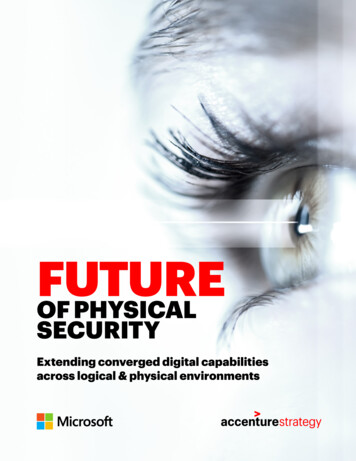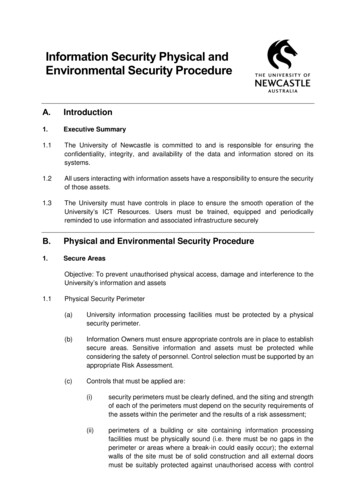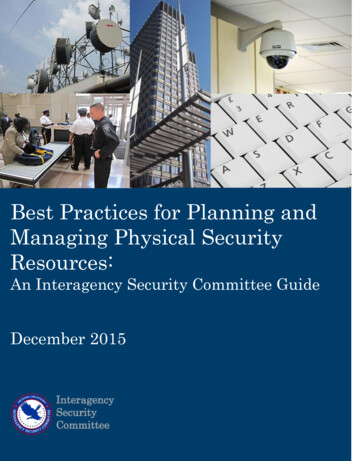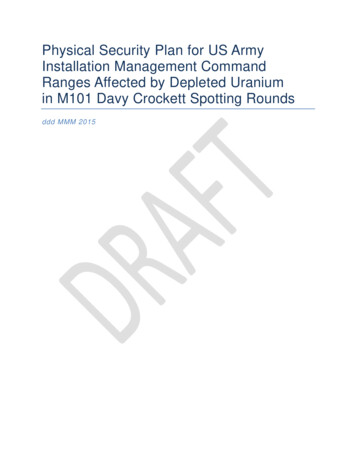
Transcription
FUTUREOF PHYSICALSECURITYExtending converged digital capabilitiesacross logical & physical environments
Table of contentsSECTION 1: Physical Security: Long Overdue for Digital Transformation . 2New Approaches for a Changing Threat Landscape2The Disruptive Force of Digital Transformation3Return on Investment4SECTION 2: Innovative Risk Management . 6Dynamic Identity Management6Robust Threat Detection and Investigation8Unification of Physical and Cyber Security9SECTION 3: Keys to Successful Transformation . 12Digital Thought Leadership13Unified Strategy: Vision to Execution14The Future of Physical Security15SECTION 4: Starting a Digital Transformation . 162 Microsoft’s Digital Transformation Journey16Microsoft Global Security17The Journey Has Already Begun18Future of Physical Security
SECTION 1:Physical Security: Long Overduefor Digital TransformationNEW APPROACHES FOR A CHANGINGTHREAT LANDSCAPEThe threat landscape is changing. The digital revolution has transformed the world in amultitude of positive ways—but it has inadvertently created new threats. Social mediaand messaging platforms are unintentionally providing new ways to plan and orchestratemass-casualty incidents. Over half of these active threat incidents occur in the workplace.Coupled with the escalation of catastrophic climate events such as hurricanes, securityteams are facing mounting challenges.Combating these threats requires intelligent applications that can rapidly sift throughoverwhelming amounts of data that cannot be processed at the human level. Recentdevelopments in artificial intelligence and signals processing can help security catchup. As tools become more sophisticated and readily available, security organizationsmust adopt new practices and capabilities. Failure to transform will increase thelikelihood of becoming a target.In 2018, Microsoft and Accenture conducted a “Future of Physical Security” survey. 200senior physical security leaders across multiple industries participated. We found thatalthough security leaders see the opportunity to enhance risk management with digitalcapabilities, the industry is at various levels of maturity, and at worst is a decade behind.Respondents identified “reactive threat management” and “intuition-led decision-makingbased on subjectivity” as the two leading challenges facing physical security operationstoday. These challenges—operating reactively and improving decision-making—make itdifficult to be proactive. This puts your people, brand and reputation at risk.Cloud computing, artificial intelligence and machinelearning with edge IoT are blurring the lines betweenlogical and physical environments. Traditional security riskmanagement and threat detection are quickly becomingobsolete. Security leaders who do not embrace a digitalmindset risk becoming business irrelevant.”– Michael Foynes, Senior Director, Microsoft Global Physical Security Operations2 Future of Physical Security
SECTION 1: Physical security: long overdue for digital transformationThe security industry is facing a huge digital disruption, and to be successful, it needsto embrace digital transformation. Maintaining the status quo will only increase thisgap and prevent companies from capitalizing on a valuable opportunity. By challengingconventional thinking and reimagining how business is done, physical security can providenext-level insights, improving life safety and creating value across the organization beyondtraditional risk management.THE DISRUPTIVE FORCE OF DIGITAL TRANSFORMATIONOrganizations are complex ecosystems. When people, processes and technologies areconnected and working together across an organization, it improves business performance.Sometimes, to improve efficiencies and break down silos, change is necessary. In theMicrosoft-Accenture Survey, 89% of Security leaders stated that digital transformation wasimportant (see Figure 1).However, only 30% deemed it urgent. This is in stark contrast to a key finding from a HarvardBusiness Review: 47% of business leaders across industries believe their business model willbe obsolete in the next two years. This makes digital transformation a matter of survival.Digital transformation of physical security is still in its infancy compared to other industries.This threatens organizations’ high-value assets—both employee life safety and intellectualproperty—and can result in missed opportunities to significantly raise the organization’sbottom line.Figure 1: Level of Priority for Digital TransformationSecurity leaders understand and recognize the importance of digital transformation.30%Important and urgent59%Important but not urgent11%Not importantSource: 2018 Accenture-Microsoft Security Survey3 Future of Physical Security35%Percent of C-levelexecutives indicating digitaltransformation is importantand urgent30%Percent of non C-levelexecutives indicating digitaltransformation is importantand urgent
SECTION 1: Physical security: long overdue for digital transformationRETURN ON INVESTMENTTraditional measures of investment success, such as return on investment (ROI),highlight the direct benefits of digital transformation. Beyond improved responsivenessto threats and more effective risk management, new physical security models deliverfaster response times at a lower cost, better security asset utilization, and improvedlifecycle management. Additionally, more than 80% of security leaders believe thatdigital transformation will deliver significant non-financial benefits such as an enhancedemployee experience; converged cyber and physical intelligence; and environments thatare not only smart but aware.Figure 2: Return On InvestmentFigure 3: Non-financial BenefitsStrongly AgreeStrongly AgreeMore than half of the respondents believedigital transformation of physical securitywill generate a meaningful return oninvestment (ROI).AgreeNeutralDisagreeStrongly Disagree41%37%18%3%1%Source: 2018 Accenture-Microsoft Security SurveyA majority of respondents believe that digitaltransformation delivers non-financial benefitsthat are worthwhile investments to theorganization, regardless of ROI.AgreeNeutralDisagreeStrongly Disagree35%45%12%6%2%Source: 2018 Accenture-Microsoft Security SurveyBy leveraging technology to generate greater intelligence, physical security will also beable to do more with less, improving operating efficiency and reducing operating andcapital expenses by up to 30-50% (depending on rollout and the size of the organization).To generate further value, organizations could take their solutions to market in a “securityas-a-service” model to help the industry as a whole achieve widespread transformation—unlocking significant business opportunities.4 Future of Physical Security
SECTION 1: Physical security: long overdue for digital transformationThe value proposition of digitaltransformation goes beyond thetraditional ROI metrics. A combinedview of returns should also measureReturn on Data (ROD), or the valuecreated from data by solutions such asadvanced analytics, artificial intelligenceand machine learning. Security leaderscan leverage these systems to createcompelling insights that can be sharedacross the organization to not onlyidentify potential security vulnerabilitiesbut to drive efficiencies, increase costsavings and elevate customer trust bypreserving privacy and security.Digital transformation is a newopportunity to provide clarity andsolutions to problems in security.– Jeff Spivey, President of Security Risk ManagementNo matter which metric the organizationprioritizes, a data strategy will be requiredto optimize the outcome. An effectivestrategy will enable physical security tobecome the core intelligence platformof the organization, transforming froma cost center into a value hub.5 Future of Physical Security
SECTION 2:Innovative Risk ManagementDigital transformation reimagines risk management. Within security there arethree elements that were either not possible before or are greatly enhancedby digital transformation: Dynamic Identity Management, Robust ThreatDetection and Investigation, and Unification of Physical and Cyber Security.DYNAMIC IDENTITY MANAGEMENTDynamic identity managementauthenticates identity—not justcredentials—and eliminates the relianceon access tokens like badges and cards.the same. Now the same tools that areused for cyber threat detection can beextended into the physical space withoutany customization or reconfiguration.It’s important to clear up the differencebetween authenticating credentials andauthenticating identity. Many securityorganizations assume they managetwo identities: a logical identity for thenetwork (user profiles, passwords) and aphysical identity for access to physicalenvironments (badges, cards).Dynamic identity management providesidentity authentication, determinesaccess privileges in real-time and enablesidentities to be tracked throughout digitaland physical environments. Imagine thata datacenter technician enters a datafacility and is immediately identifiedthrough facial recognition, automaticallygranting access to authorized areas.As the technician moves through theenvironment, IoT sensors and devicescollect additional intelligence in real time,tracking movement and activity.However, this is credential authentication,not actual identity authentication. Toenable a single digital identity that isauthenticated across logical and physicalenvironments, security organizationsneed a combination of digital capabilitiesincluding facial recognition, videoanalytics and IoT sensors. In effect,these digital representations of physicalenvironments combine to make logicaland physical environments one and6 Future of Physical SecurityUsing this data, the dynamic identitymanagement system learns thetechnician’s normal patterns for accessingserver rooms and associated servicerequests and builds a behavior profile.
SECTION 2: Innovative risk managementOne day, the technician attempts toenter the main server room and thesystem recognizes that there are nocorresponding service requests. Thesame learning engines that are used topinpoint a suspicious activity—like anunauthorized user attempting to access anetwork—detects an unauthorized entryattempt. As this anomaly is detected,quick action by a digital officer or smartbot mitigates the threat by removing thetechnician’s access.Digitizing an individual’s physical identityallows security organizations to leveragecyber skills and capabilities in thephysical environment. By viewing thephysical world as a network with a singleidentity, security organizations are betterequipped to handle dynamic accessmanagement.DEFINITION: DIGITAL OFFICERA security officer digitally enabled with datainsights in real-time to respond to incidentsSCENARIO: DATA CENTER TECHNICIAN01Data center technician arrives at data facility for work, facial recognition clearsthem for entry to the environment based on their dynamic risk-profile02IoT sensors and devices monitor locations and converges physical and cybersecurity to facilitate and control access03IoT sensors and devices record individual’s interactions with an environment(e.g., location, time, etc.)04IoT sensors establish a baseline behavior of a profile user and detects andrecognizes uncorrelated users05Employee attempts to enter unauthorized area of data center06The combination of logical and physical identity pinpoints the suspicious activity,guiding the digital officer to remove the technician from the environmentA BENEFIT FOR CUSTOMERSCustomers also receive a better experience when dynamic identity management isdeployed. London’s Heathrow Airport and the UK Border agency teamed with Accenture tocreate an interconnected system of data streams, biometrics and facial recognition tools tomatch identity and passport data with incoming travelers. The system monitors activity andensures that travelers stay on the right path and verifies that identities match documents.For both security and travelers, the experience is simple, efficient and effective.7 Future of Physical Security
SECTION 2: Innovative risk managementROBUST THREAT DETECTION AND INVESTIGATIONIdeally, every security professional wouldhave the tools to proactively assess andmanage risk. However, the complexityof managing current threats often getsin the way, leaving less time to focus onproactive threat management. Digitaltransformation empowers these operatorswith systems that contextualize data toidentify threats before they occur, mitigaterisks and better ensure life safety.Today’s model relies heavily on manualprocesses, which often results in missedsignals. It is nearly impossible—not tomention costly—for humans to monitor allsecurity content without digitally poweredanalytics. That’s why it is commonlyestimated among security professionalsthat more than 90% of security videofootage goes unseen and is typicallywatched only for reactive investigation.Physical security leaders know thismodel needs to change, and that dataand analytics is the answer: over 80% ofsurveyed participants identified big dataand analytics as a top three investmentfor the next 3-5 years.Figure 4: Top InvestmentsOver the next 3-5 years, security leaders selectedthe following as their top three areas of investment.Big data & analyticsCloud computing & storageAdvanced identification83%58%56%Source: 2018 Accenture-Microsoft Security SurveyAs physical security organizations transform to harness thepower of data, they must also make data protection andprivacy a priority. Currently, the General Data ProtectionRegulation (GDPR) requirements provide a clear guide tocompliance, but data management systems should beflexible as regulations continue to evolve in the future.Monitoring and analyzing data is only half of the equation: intelligen
and messaging platforms are unintentionally providing new ways to plan and orchestrate mass-casualty incidents. Over half of these active threat incidents occur in the workplace. Coupled with the escalation of catastrophic climate events such as hurricanes, security teams are facing mounting challenges. Combating these threats requires intelligent applications that can rapidly sift through .











